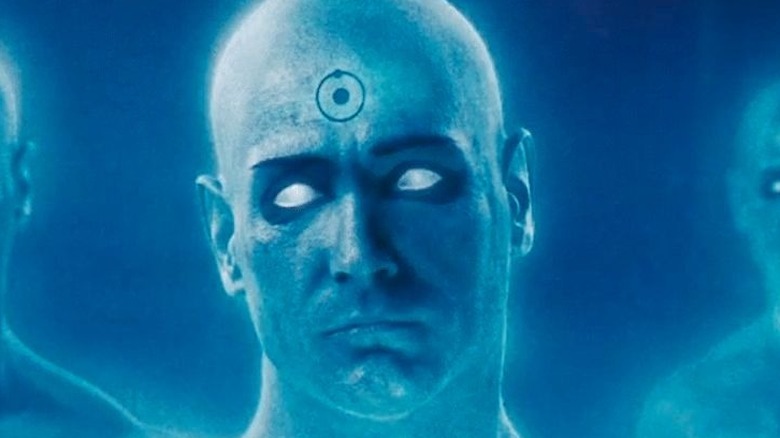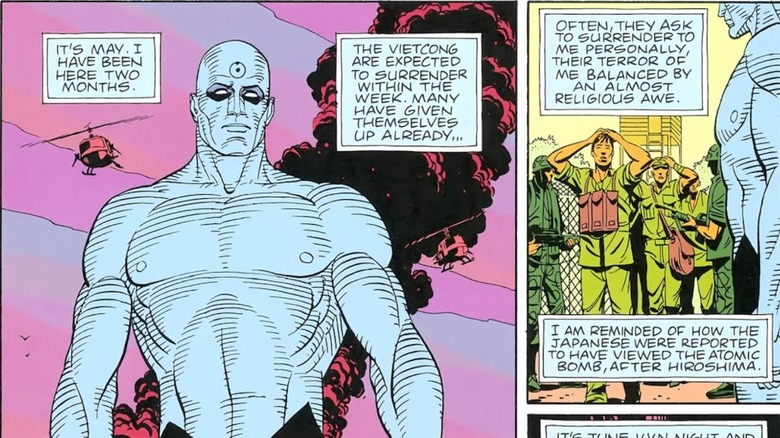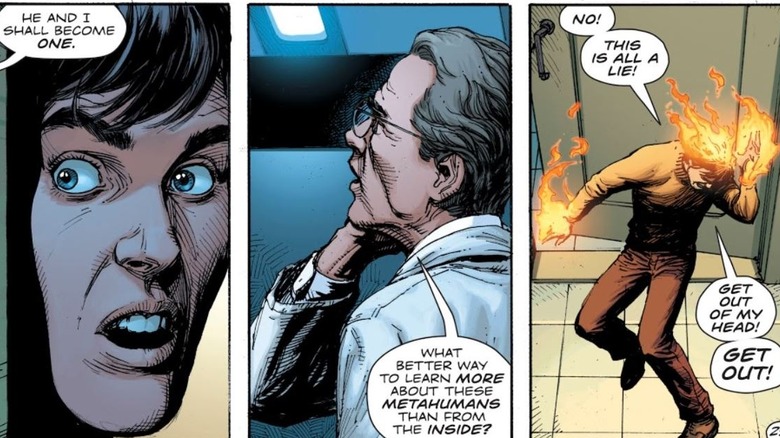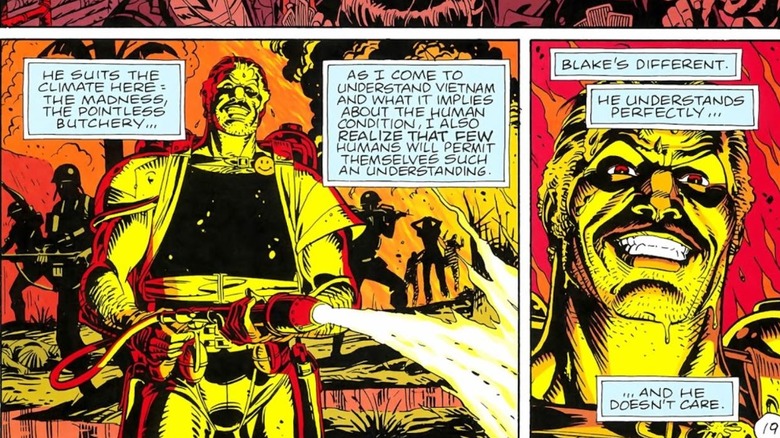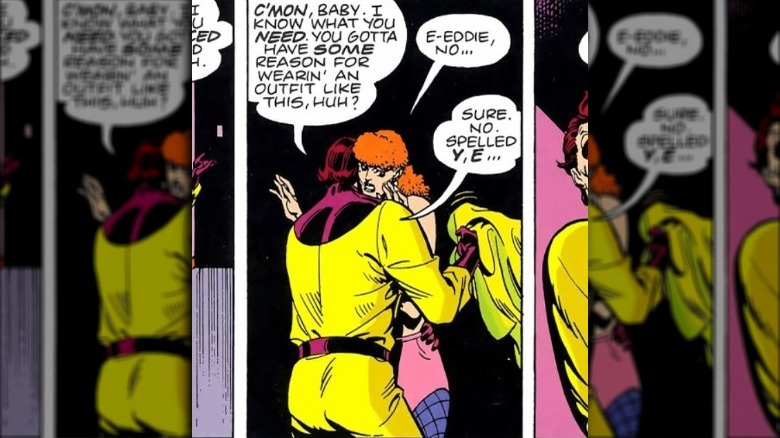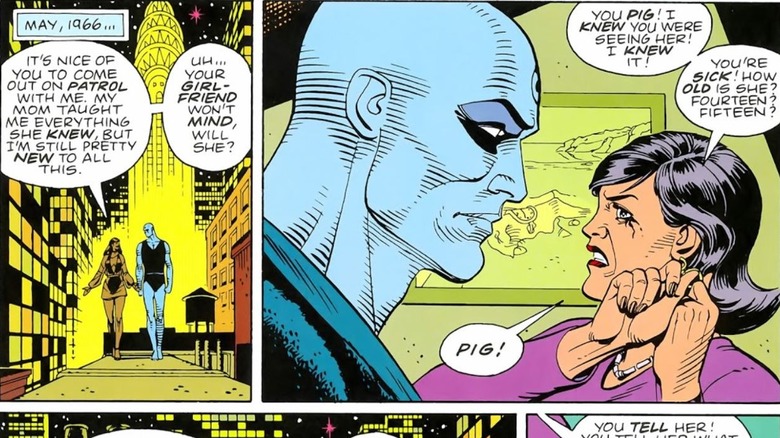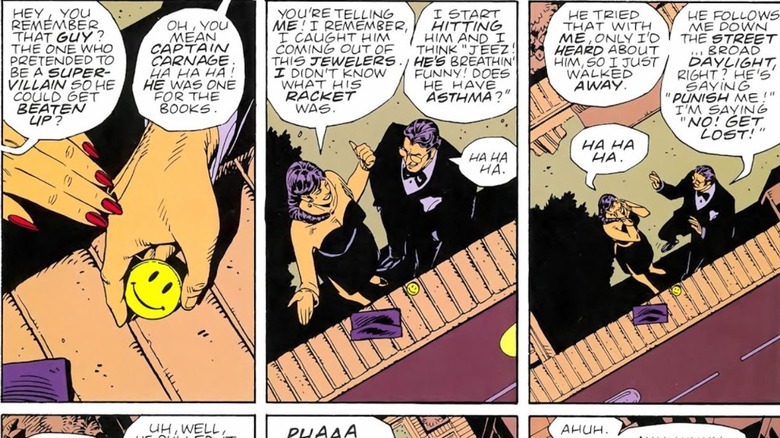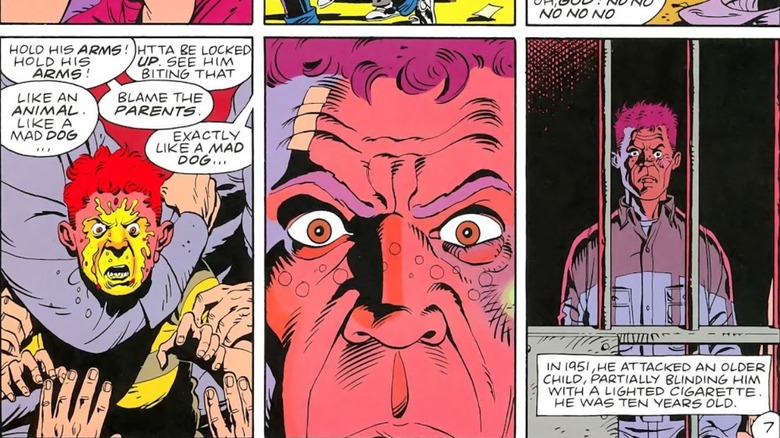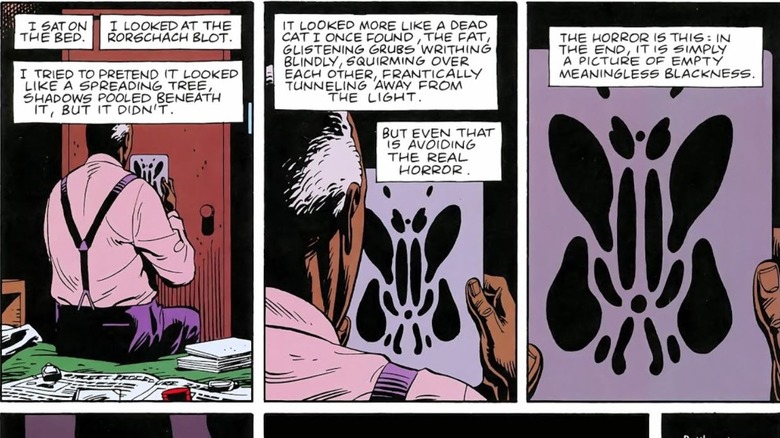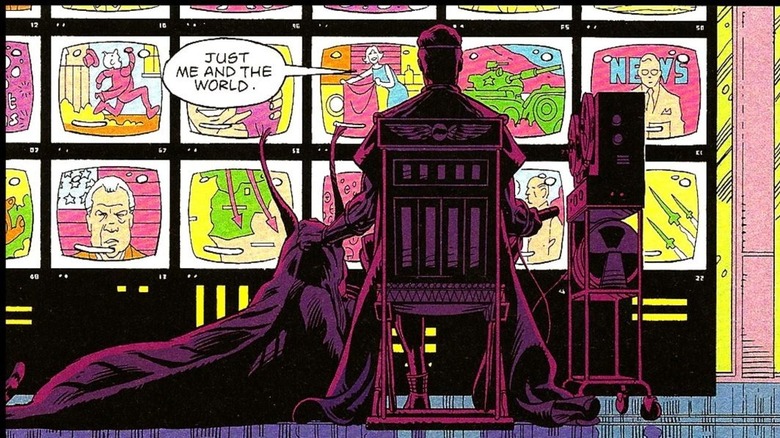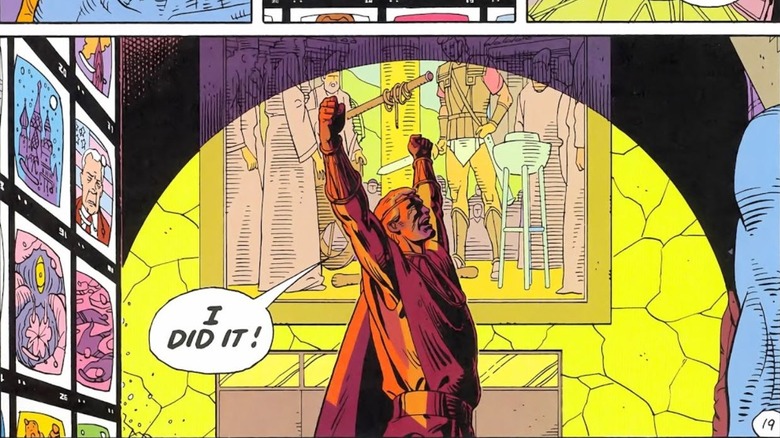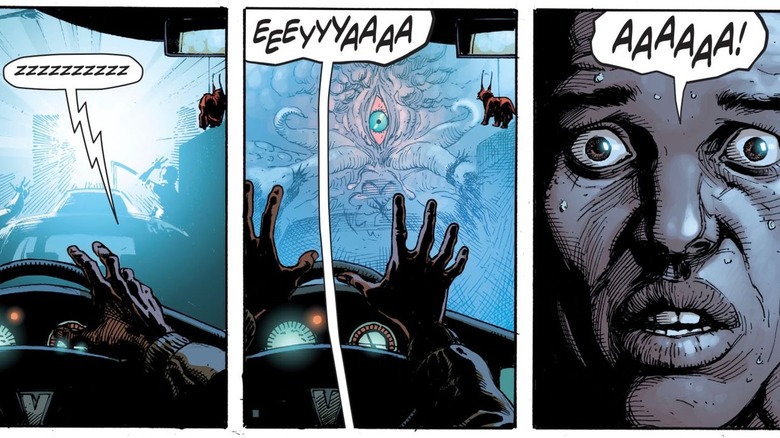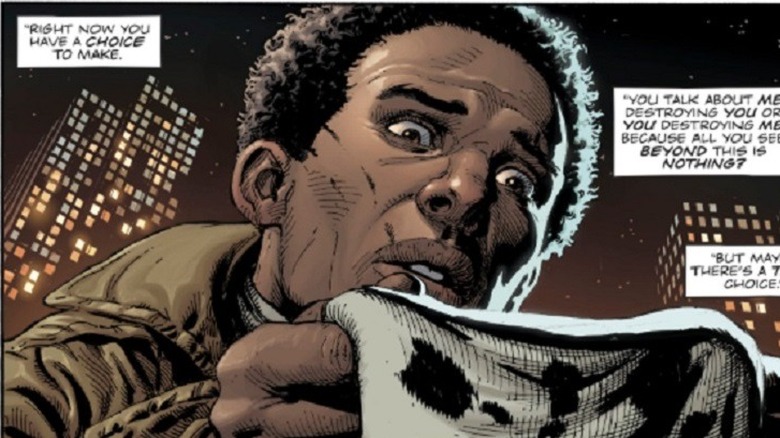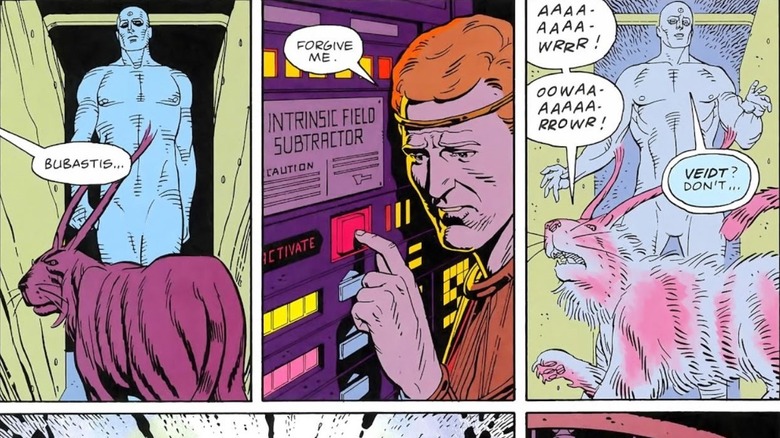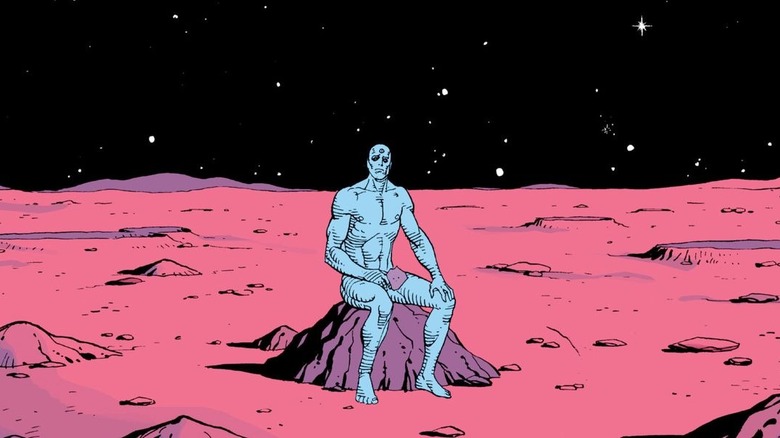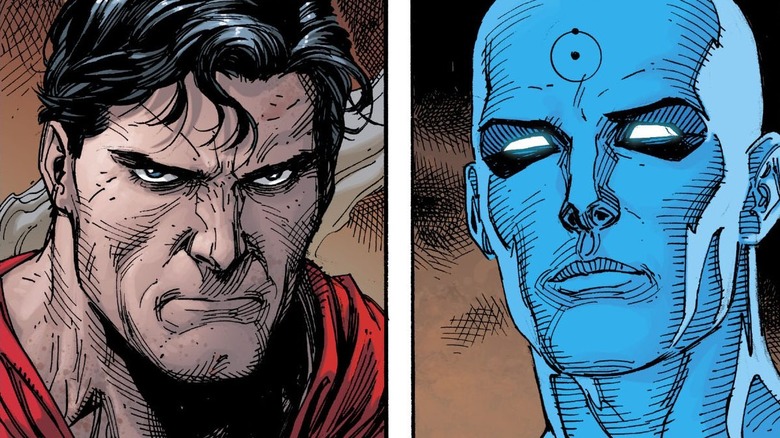The Dark History Of Watchmen
Alan Moore's "Watchmen” artfully examines some of the United States' most complex and controversial aspects of its society and history. This alternate comic book history is set in a right-wing, post-Cold War-era USA that won Vietnam, has re-elected Richard Nixon multiple times, prints his likeness on currency, and celebrates "Hiroshima Week." The caped crusaders in "Watchmen" are as cold and jaded as their reality — gritty characters who are loaded with imperfections and represent a host of conflicting ideals and interests.
It's hard to love any of the people presented in the "Watchmen"-related stories, even the so-called heroes, and they aren't the kind of thing you read when you're looking for happy endings. There's also beauty in these stories — from Dave Gibbons' fabulous art to the brilliant coloring of John Higgins and the mind-blowingly meta nature of the plot — and ensuing "Watchmen" series like "Doomsday Clock" and "Before Watchmen" are also beautiful to behold and entertaining to read. Still, it's the darkness of the "Watchmen" universe that's helped set it apart, so let's take a look at the dark history of this franchise.
'Superman is real, and he's American'
The plot of "Watchmen" is complex, but when simplified, the main premise questions what the world would be like if super-powered humans were real, and how their existence would influence life in a realistic sense. Like atomic weapons and nuclear power, the very existence of caped crusaders would surely become politicized, and countries would race each other to stockpile these newly discovered "weapons."
This is exactly what happens in the world of "Watchmen" — metahumans are used to win wars rather than stop them. It's no surprise, then, that Doctor Manhattan is the moniker given to the story's most godlike super-being: "The Manhattan Project" was the name given to the top-secret US project researching the technology behind nuclear power. Before his transformation, Manhattan was a scientist named Jon Osterman who had a nuclear lab accident which seemed to disintegrate him, but actually caused a sort of rebirth.
After slowly reappearing in a very creepy and painful way, he became an omnipotent, omnipresent being — one with a thing against pants, for whatever reason. In the alternate history of "Watchmen," America won the Vietnam War just a few months after Manhattan's appearance. Meanwhile, the caped crusaders at home squashed anti-war protests, protecting the government's interests while infringing on the freedom and security of those they were supposed to protect.
The Superman theory
The United States has a not-so-spotless past when it comes to protecting its perceived interests, some of which seem stranger than fiction, like The Bay of Pigs Invasion. One such conflict spurring division in the world of "Watchmen” is the spread of a conspiracy theory that the American government sponsored programs to create their own metahumans. Dubbed the "Superman theory," this conspiracy theorized the government created seemingly random accidents which would trigger a recently discovered "metagene," which can result in super powers when activated by an extreme stress.
Unfortunately, this turns out to be partially true, as is revealed in the tragic backstory of Project: Firestorm. Initially introduced in 1978 in DC's "Firestorm" #1, high school student Ronnie Raymond was fused with his science teacher, Martin Stein, in a freak accident, creating a powerful being known as Firestorm. The two formed a sort of father-son relationship, with Stein advising the teenager, who held control of their superpowered body.
Doctor Manhattan reveals the truth of the accident in "Doomsday Clock" #9, transporting Ronnie to the moments before that fateful accident. Turns out, Stein set it up purposefully to fuse with a metahuman, study them from "the inside out," and share his research with the government.
It's all a big joke
He isn't a funnyman in the traditional sense — Edward Blake aka the Comedian is given his moniker because of an extremely fatalist worldview and a morbidly dark sense of humor. Like the Joker, Blake has an insatiable thirst for unbridled violence, only he's able to freely express his psychopathic tendencies because he's a soldier fighting to protect America's interests — which does have a dark irony to it.
According to "Before Watchmen: Comedian" #1 and #6, Blake was responsible for the tragic deaths of Marilyn Monroe and Bobby Kennedy, and he committed countless horrific acts during his time in Vietnam. One of the more chilling: He led the massacre of a village containing hundreds of mothers, children, and elderly folk who were unfit to fight — even their animals weren't spared.
When he learns the war is over and he'll be going home, the Comedian kills a woman carrying his child when she argues with him about leaving her behind. That's how he got that scar running down his face — she cut him with a bottle when he told her he didn't care about her. Perhaps the scariest aspect of the Comedian is that people like him are real, as are the special interests they represent.
Keep your enemies close
The Comedian's atrocities aren't limited to his time in active duty, as a fellow vigilante would learn the hard way. Until he took things too far, the Comedian was a member of the Minutemen, the first group of heroes in the "Watchmen" universe. They consisted of a waitress and burlesque dancer turned superheroine named Sally Jupiter; the first masked vigilante, Hooded Justice; a brilliant inventor known as Mothman; children's rights activist Silhouette; Dollar Bill, a corporate superhero sponsored by a bank; police officer-turned-vigilante Nite Owl; and the sadistic Comedian.
After the close of a Minutemen meeting, Blake followed Sally uninvited into the room where she was changing. When she declined his advances, he assaulted her, and would have done worse had he not been interrupted by Hooded Justice. In an even more uncomfortable twist, Sally later has a daughter named Laurie, who grows up without knowing who her father is — only to find out on her own that he's none other than the Comedian.
Apparently, Sally found herself attracted to Blake after the assault, despite how traumatic it had been. This unnerving discovery causes a paradigm shift in Laurie's reality, and sets her on the path to growing into the woman she becomes on HBO's "Watchmen" series.
Forbidden love
Speaking of the HBO "Watchmen" series, although Laurie is a mature woman in the show, she first hooked up with Doctor Manhattan as a teenager, and he was the equivalent of 30. To make matters worse, Manhattan was already seeing a woman at the time, Janey, and lied to her about never leaving her.
He even gifted Laurie with the same set of earrings he'd given his ex, which she'd thrown on the floor on her way out the door. Thanks to his atomic powers, Manhattan remained ageless while everyone around him grew old and died. He found Janey's aging growing more apparent every day, and was drawn to the vitality and high spirits of a young woman in silk at the first meeting of the Crimebusters, Captain Metropolis' second group of masked vigilantes.
Laurie's mother had vigorously trained her for the moment she would take up the mantle of Silk Spectre. She was thrilled when Laurie was accepted into the Crimebusters, albeit less so about her relationship with Doctor Manhattan — although, ironically, more because she likened it to "sleeping with an H-bomb," and less because her underage daughter was in an intimate relationship with a man nearly twice her age.
Captain Carnage
Dating a godlike being can be hard when you're a mere mortal, a struggle Laurie learns the hard way while living with Doctor Manhattan. His transcendence of time and space makes him detached, and Laurie finds herself drifting further from him each day. She seeks the comfort of a fellow former masked vigilante over dinner, a man named Dan Dreiberg who was inspired to take up the mantle of Nite Owl for the Crimebusters after the first one retired.
While catching up about old times, the two bring up one of the villains they used to face. Dubbed Captain Carnage, he made a name for himself committing crimes in the hopes of getting caught — but as it turns out, Carnage was a masochist who enjoyed taking a good beating from superheroes. Laurie recalls a time she caught him red-handed after robbing a jewelry shop, but when she took him down he started "breathing funny." She thought he was having an asthma attack at first.
When Dan recalled encountering Captain Carnage, he was already familiar with his antics, so he just walked away from the encounter. Carnage then ran after him, yelling "Punish me!" Carnage met his end when he tried to pull his twisted shenanigans on the most ruthless Crimefighter, Walter Kovacs, aka Rorschach.
The making of Rorschach
Captain Carnage wasn't the only baddie who learned the hard way not to cross Rorschach. His twisted and rigid sense of justice left no room for grey areas, which when combined with his ruthless tactics and paranoid outlook made for an extremely violent vigilante. Extreme personalities like Rorschach don't just spring up out of nowhere — they're forged through a lifetime of abuse, neglect, bullying, loss, and mental illness.
Kovacs had more than his fair share of all of the above while growing up with an abusive mother. With no father around to provide guidance or additional income, Mrs. Kovacs found herself resorting to ever more scandalous means of providing for her and her son, whom she resented (and made that resentment known through ugly words and harsh beatings). Neighborhood kids bullied young Kovacs over his mother's occupation, until one day he snapped and fought back wildly.
One of the bullies was smoking a cigarette, which Kovacs pulled out of his hand and stuck into one of the young assailant's eyes, leaving him partially blind. This was Kovacs' first violent outburst, and first time getting in trouble with authority, which resulted in the subsequent investigation of his home life and placement into foster care. When his mother was later murdered, young Kovacs merely muttered, "Good."
Staring into the abyss
Rorschach winds up in prison after being set up by Adrian Veidt. Insights into Kovac's traumatic past, and the inspirations for taking on his alter ego, are divulged in "Watchmen" by his prison-appointed psychologist, Malcolm Long. When he first meets Rorschach, Long has an unflappable, cheery disposition which seems to starkly contrast against the cold walls of Sing Sing Correctional Facility.
He feels confident he can crack through the Rorschach persona and reach the vulnerable Walt Kovacs underneath. However, each session with Rorschach leaves Long more drained of his sense of hope and less grounded in his own beliefs — as though Rorschach were some sort of spiritual vampire. The panels place subtle hints at Long's deterioration, like increasing the number of over-the-counter pain pill bottles he has scattered across his desk and increasing his coffee intake.
By the end of the graphic novel, Long has become so absorbed in the Rorschach case that his marriage has deteriorated. He even starts thinking and speaking like Rorschach — in clipped, terse sentences lacking articles and pronouns. Perhaps the darkest thing about "Watchmen" is how eagerly it embraces the idea that darkness breeds darkness simply through proximity.
Look on my works, and despair
As scary as psychopaths like Rorschach and the Comedian can be, the true villain in "Watchmen” is the world's smartest man, Adrian Veidt — similar to Lex Luthor, but somehow more narcissistic and grandiose. He strives to emulate ancient monarchist-conquerors like Alexander the Great and Ramses II, and cultivates a similar superiority complex which convinces him he is the only one capable of saving the world.
At first, he exercises his plans for salvation by working as a vigilante for the Crimebusters under the persona Ozymandius, but the group is disbanded when the Keene Act of 1977 makes non-government sanctioned superheroes illegal. Veidt then busies himself with expanding his influence and business empire, until the Cold War of his world starts to get much hotter than ours. As tensions between superpowers escalate into full-on nuclear war, Veidt takes it upon himself to save the world by giving it a shared enemy all could unite together in solidarity against.
Using his vast wealth and intellect, Veidt recruits various artists and scientists to work under his instruction in secret on a remote island. His twisted end goal? To create a creature which would appear to be an alien from another dimension and unleash it on New York City, where it would explode and cause massive death and destruction — all in the name of disrupting impending nuclear war and uniting the world in peace against a far bigger threat.
For the greater good
Unfortunately, Veidt is successful in executing his plan, which results in a sort of psychic bomb dropping in the heart of bustling New York City. Millions of New Yorkers die instantly and in terribly gruesome manners, which results in an immediate call for peace from all nations. This makes Veidt a hero in his own eyes — he feels no remorse for his actions, and to make matters worse, those who could have held him accountable end up conspiring with him in the end.
Silk Spectre, Nite Owl, Rorschach, and Doctor Manhattan all set out to stop Veidt from enacting his horrific plan, only to find he'd set it in motion long beforehand. Once they see news reports of world peace and unification in the face of the supposed alien attack, the superheroes agree that sharing the truth with the world would only plummet it back into chaos.
Everyone agrees, that is, except for Rorschach, who has his own set of morals, even if they are a bit extreme. As a result of his refusal to cooperate, Manhattan disintegrates Rorschach — an act as cold as the snow upon which it took place.
Leaving a path of destruction
The atrocities committed by Veidt go beyond his staged alien attack and its resulting deaths. In his efforts to see his plan through to fruition, he causes the deaths of many innocent bystanders and ruins the lives of others. He eliminates his biggest threat, Doctor Manhattan, by secretly giving cancer to several of his loved ones and associates, making it look like his atomic powers were dangerous to anyone near him. Troubled, Manhattan leaves the planet for the sanctuary of Mars.
Unencumbered, Veidt sets up multiple assassinations, one of which is a staged attempt against himself to remove suspicion. Tragically, the bullet intended for Veidt strikes down a young woman next to him — but like the rest of his victims, she's just a pawn in Ozymandias's ruthless game.
On the eve of his staged alien attack, Veidt evacuates his secret island under the guise of moving his team to another safe spot, only to bomb the ship and sink it so no survivors would live to tell. Veidt's perpetual webs of deceit expand in "Doomsday Clock" — only this time, it results in the destruction of his and Superman's worlds, and the rebirth of the DC universe.
Rorschach: Rebirth
In addition to the instant deaths caused by Veidt's explosion, people worldwide were left reeling from psychic vibrations it emitted like shockwaves, many severely traumatized — some even driven completely insane. One of these unfortunate souls is Reggie, the son of Malcolm Long, who was trapped in a car in traffic up the street from where his father was arguing with his then-estranged mother when the attack hit. Reggie was saved from certain death by his car, but his parents weren't so lucky.
Reggie underwent months of treatment at a mental facility where it so happened that Byron Lewis, a former Minuteman known as Mothman, was also being institutionalized. Byron provided a sort of anchor for Reggie, even managing to sneak some of Malcolm Long's personal belongings to him — including Rorschach's journal. This twisted tome provides the perspective from which most of the graphic novel is told, and through it Reggie regained his strength.
Reggie didn't know Lewis kept his father's notes from him, fearing the insights into his crumbling life and marriage would mar his son's posthumous perspective of his father. So it's with a sort of dark irony that once he escapes the mental facility, Reggie dons Rorschach's mask and persona to cope with his trauma — not realizing he's idealizing the very man who destroyed his father.
Innocent bystanders
As if all the horrific events Ozymandias engineers aren't bad enough, even his pet cat, Bubastis, suffers under his plan. Veidt raised Bubastis since her birth in the lab, nurturing her and giving love and protection, and during the time she spent with him, Bubastis acted as his sole companion and confidant. She also served as an intimidating bodyguard. This kinship ultimately means nothing to Veidt, however.
When Veidt finds himself facing the wrath of Doctor Manhattan, he manages to trick him into walking back through the same kind of atomic machine that caused his painful and traumatic transformation. Unfortunately, when he turns it on, Bubastis is also inside. Veidt manages to resurrect his feline friend in "Doomsday Clock," with the added perk that the energy she absorbed from Doctor Manhattan makes her behave like both a compass and shield to his energy, but that doesn't erase his callous murder of Bubastis in the first place.
When good men do nothing
Almost worse than Ozymandias' twisted savior complex is Doctor Manhattan's detached attitude toward relationships and human affairs. After acquiring his godlike powers, he fails to do a single thing about all the horrible events taking place in his world.
Instead of using his powers to stop the Vietnam War, he fights on the side of the Americans. Not once does he lift a single blue finger to prevent people like the Comedian or Ozymandias from committing horrific atrocities, and eventually, he leaves his planet on the brink of war and runs off to Mars.
Manhattan only uses his powers to rescue two of the worst people on his planet — the murder-happy Comedian and Marionette — and only because they served his purposes, not because they helped mankind. Doctor Manhattan is almost like an anti-Superman ... which may be why Manhattan eventually becomes so fixated with him.
Man of Tomorrow
In the final panels of "Watchmen," Doctor Manhattan tells Ozymandias he's leaving their universe for a "simpler" one. When the story picks up again in "Doomsday Clock," it's revealed that Manhattan has left for the same universe that Superman and Batman exist in. In his omniscient state, the one thing he can't see past is his initial encounter with Superman, which makes him wonder: "Does this mean he destroys me, or I destroy everything?"
Fascinated with this other being's importance, Manhattan tinkers with the multiverse, altering timelines and events to see how various outcomes alter Superman's perceptions, motives, and world views. In doing so, he learns this Man of Tomorrow represents a beacon of hope, whose very existence acts as an anchor to all the other worlds within the DC multiverse — making Superman's world a sort of metaverse.
After coming to terms with this understanding, Superman helps Doctor Manhattan see it doesn't have to be all hopeless destruction, and Manhattan uses his transcendence of time and space to eliminate nuclear bombs — and go back in time to prevent his transformative accident from happening. In the process, DC is able to tie up loose ends from conflicting multiverses, and launch a clean slate for fresh canon under the 2016 "Rebirth" launch. All's well that ends well — but how many lives were destroyed along the way?
